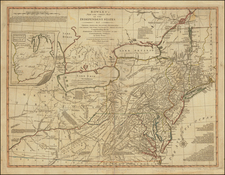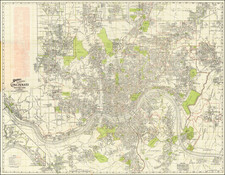French Edition of First Map of Kentucky -- Bound with Filson's History of Kentucky -- "The First History of Kentucky"
Nice example of the French edition of John Filson's important early book and map of Kentucky, published in Paris in 1785.
The French edition, translated by Parraud, contains additions not in first American or English editions.
Filson's map was first published in Wilmington, Delaware in 1784, and is generally considered the first important map of Kentucky. The French edition, issued in the same year as the Wilimington edition, is very similar to the Wilmington edition and was issued 9 years prior to Stockdale's 1793 London edition of the map, which also include significantly more alterations to the original map.
Kentucky is shown divided into the counties (Comte) of Lafayette, Lincoln and Jefferson and numerous settlements are located and named. The roads between the principal towns are shown by means of dotted lines, plus the following "Path of Cumberland Settlement, The Road from the Old Settlements in Virginia to Kentucky thro' the great Wilderness, Genl. Clark's War Road going, Birds War Road, &c."
The map is accompanied by two volumes of text related to American life after the Revolution including Crevecoeur’s Lettres d'un Cultivateur Americain (1784 edition, 2 volumes: 422 pp. and 400 pp., no maps) and the French edition of Filson’s Histoire de Kentucke, Nouvelle Colonie a l'Ouest de la Virginie at the end of the second volume (1785 edition, 234 pp.).
The French edition of the Filson book includes a vast array of information on Kentucky, including the discovery, the acquisition, the establishment, and a description of the topography and nature. Also included is some history on Colonel Daniel Boone (helping his notoriety) and the Native Indians in the region. 12mo, hardbound in original red boards with ribbon page marks.
As noted by William Reese:
The first French edition of Filson's pioneering history of the settlements in Kentucky, issued the year after the extremely rare Wilmington, Delaware edition. "The most famous and important frontier book of the period . . . particularly important for the first map of Kentucky and the first published life of Daniel Boone" (Vail), including an account of Boone's captivity. W.R. Jillson, in the introduction to his reprint of Filson, says that Filson "has left to posterity a priceless tale of early days in Kentucky, which, for stirring action and regional description, has rarely been equalled as a piece of frontier writing in any part of the country, and never surpassed." The map was the first to provide an accurate delineation of Kentucky, and this is the first obtainable edition, as the American first is known in only a few copies.
A fine example of the map, with the two books in original 18th Century bindings in nice condition.
John Filson
John Filson was born in Chester County, Pennsylvania, in 1747 and served as an Ensign in Montgomery's Pennsylvania Battalion of the Flying Camp and was taken prisoner at Fort Washington during Battle of New York in 1776. After the war, Filson worked as a surveyor in Pennsylvania until 1782 or 1783, when he acquired over 13,000 acres of western lands and moved to Kentucky. He settled in Lexington and travelled the region interviewing the settlers and leading citizens, where he wrote The Discovery, Settlement and Present State of Kentucke (1784). He also had his Map of Kentucke engraved and printed in Philadelphia. The book was almost immediately translated into French and re-published in Paris (1785) and somewhat later a German edition appeared (Leipzig, 1790).
After several years in Kentucky, Filson purchased from Mathias Denman a one third interest in an 800 acre tract at the junction of the Ohio and Licking rivers, the future site of Cincinnati, which he called Losantiville. Filson's survey and plan of the town survives in the layout of modern downtown Cincinnati. General Arthur St. Clair, Governor of the Northwest Territory, later changed the name of Losantiville to Cincinnati in honor of the Society of the Cincinnati, an organization of Revolutionary War officers founded by George Washington.
John Filson was born in Chester County, Pennsylvania, in 1747. Filson attended the West Nottingham Academy in Colora, Maryland, and studied with the Reverend Samuel Finley, afterwards president of the College of New Jersey (later Princeton). Heitman's Historical Register of Colonial Officers reports a John Filson served as an Ensign in Montgomery's Pennsylvania Battalion of the Flying Camp and was taken prisoner at Fort Washington during Battle of New York in 1776.
Filson worked as a schoolteacher and surveyor in Pennsylvania until 1782 or 1783, when he acquired over 13,000 acres of western lands and moved to Kentucky. He settled in Lexington, taught school, surveyed land claims, and travelled the region interviewing the settlers and leading citizens. He wrote The Discovery, Settlement and Present State of Kentucke (1784) during this period, and travelled to Wilmington, Delaware, to have it published in the summer of 1784. He also had his Map of Kentucke engraved and printed in Philadelphia. The edition, including both book and map, consisted of 1,500 copies and was priced at $1.50. The map was reprinted several times before 1793. Filson's plan for a second edition, to be endorsed by George Washington, was unsuccessful.
The book was almost immediately translated into French and re-published in Paris (1785) and somewhat later a German edition appeared (Leipzig, 1790). The appendix relating the adventures of Daniel Boone was extremely popular, and was referenced by (among others) Lord Byron in Don Juan.
Filson also wrote an unpublished manuscript entitled A Diary of a Journey from Philadelphia to Vincennes, Indiana, in 1785; An Account of a Trip by Land from Vincennes, hid., to Louisville, Kentucky, in 1785; A Journal of Two Voyages by Water from Vincennes to Louisville, and an account of an attempted voyage in 1786.
After spending several years in Kentucky teaching school, surveying, trying (unsuccessfully) to start a seminary, and becoming embroiled in numerous lawsuits and financial difficulties, he purchased from Mathias Denman a one third interest in an 800 acre tract at the junction of the Ohio and Licking rivers, the future site of Cincinnati, which he called Losantiville. Filson's survey and plan of the town survives in the layout of modern downtown Cincinnati. General Arthur St. Clair, Governor of the Northwest Territory, later changed the name of Losantiville to Cincinnati in honor of the Society of the Cincinnati, an organization of Revolutionary War officers founded by George Washington.
While on a surveying expedition near the Great Miami River, he disappeared, October 1, 1788, when his party was attacked by Shawnees.











![The North Coast of the Gulf of Mexico from St. Marks to Galveston . . . 1844 . . . Additions to 1856, including the Surveys of Comr. Powell, Lt. Simmes & Profr. Coffin, U.S. Navy [and] St. Marks to Galveston. Sheet II. . . . 1845. Additions to 1851 . . . .](https://storage.googleapis.com/raremaps/img/small/89497.jpg)
![[ Southern Railroads ] Railroad Map of the Southern States Shewing the Southern & Southwestern Railway Connections With Philadelphia. 1862 . . . Prepared by Thomas Kimber Jr., Chairman of the Committee on Inland Transportation of the Board of Trade of Philadelphia](https://storage.googleapis.com/raremaps/img/small/103211.jpg)
![The Marseilles Hymn. In French & English. Marche des Marseillois [First American edition of the Marseillaise and 30 other mostly American music sheets from the late 18th century and early 19th century]](https://storage.googleapis.com/raremaps/img/small/73106.jpg)


![[Hand Drawn Map] Le Golfe de Mexique avec les Pays Circonvoisins](https://storage.googleapis.com/raremaps/img/small/91580.jpg)